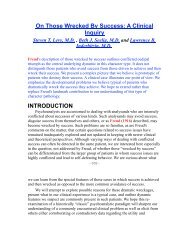A Sadomasochistic Transference - Beth J. Seelig, MD
A Sadomasochistic Transference - Beth J. Seelig, MD
A Sadomasochistic Transference - Beth J. Seelig, MD
You also want an ePaper? Increase the reach of your titles
YUMPU automatically turns print PDFs into web optimized ePapers that Google loves.
self-object. The particular vulnerability of narcissistic characters to failures of<br />
empathy on the part of the analyst is one of his concerns. Stern's (1985) work<br />
- 983 -<br />
on the function of attunement between infants and mothers highlights the critical<br />
importance of the very early mother-child experience in validating the child's<br />
budding sense of agency, and the negative consequences when the sense of agency<br />
is thwarted. Consistent misreading of the child's cues by the mother is one source<br />
of serious pathology in the child, which is clearly manifested in the rapprochement<br />
phase, as described by Mahler et al. (1975), and which often takes the form of<br />
sadomasochistic character pathology. Although Stern and Mahler have remarkably<br />
different concepts of the origins of the infant's earliest sense of self, parts of their<br />
theories overlap, though with different emphases. Both accounts are useful to our<br />
understanding of the genesis of sadomasochistic pathology in this patient and<br />
other similar patients.<br />
During the rapprochement phase of development, according to Mahler, the<br />
child's euphoric sense of itself (the so-called love affair with the world) succumbs<br />
to the necessity of reconciling its expansiveness with the realization of limits.<br />
Cooper (1988) argues that the narcissistic injuries from this period of life<br />
inevitably invoke reparative masochistic mechanisms to restore self-esteem. The<br />
child does this, according to Cooper, by declaring its suffering ego-syntonic—<br />
willed by itself. Thus he sees at least some minimal masochistic characteristics as<br />
universal, part of normal development. He goes on to argue that if narcissistic<br />
humiliation is excessive, then the child is rendered incapable of authentic selfassertion;<br />
accordingly, the goal becomes "not a fantasied reunion with the loving<br />
and caring mother" but rather "a fantasied control of a cruel and damaging mother"<br />
(p. 128). He correctly concludes that the goal of sadomasochistic defenses is not<br />
sexual pleasure, but the stabilization of the self-concept and self-esteem, thereby<br />
shifting our understanding of masochism from an exclusive focus on the superego<br />
(punishment to preserve pleasure) to narcissistic defenses to preserve self-esteem.<br />
- 984 -<br />
In a paper on masochism, Kernberg (1988a) contrasts the depressivemasochistic<br />
patient's extreme vulnerability to disappointment with that of the<br />
narcissistic personality "who is over-dependent on external admiration without<br />
responding internally with love and gratitude, [while] the depressive-masochistic<br />
personality typically is able to respond deeply with love and to be grateful" (p.<br />
108). He agrees with Cooper that masochistic patients obtain narcissistic




